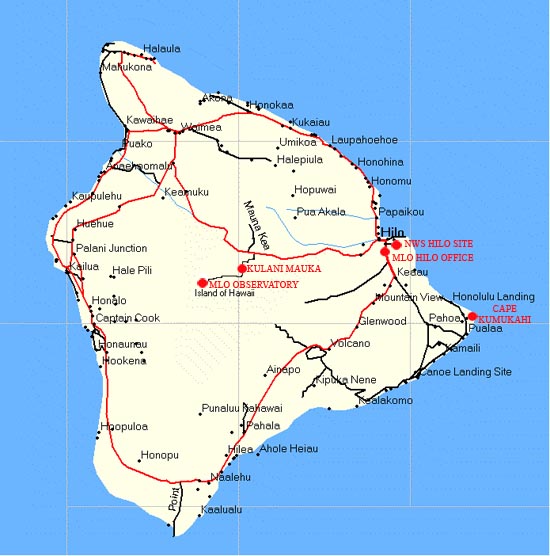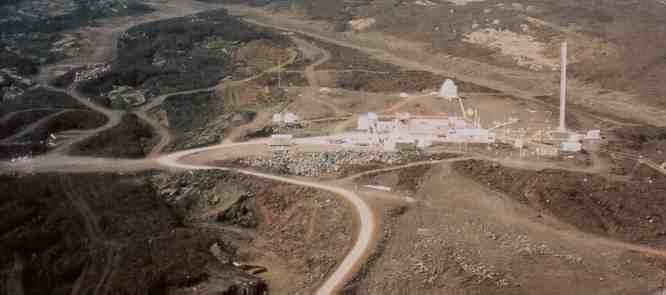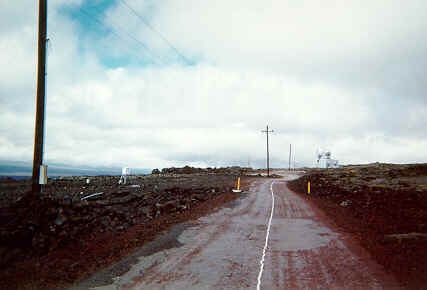More than two years after road access and electrical power to the Mauna Loa Observatory was cut off by lava flows, NOAA staff continue to make critical measurements of the atmosphere and other environmental variables at the remote site.
In 2023, observatory staff installed solar panels at the site and resumed some measurements, including the independent carbon dioxide monitoring programs run by the Global Monitoring Laboratory and Scripps Institution of Oceanography, as well as other atmospheric measurements.
Construction of a temporary road to access the observatory site is anticipated to begin in summer 2025.
Media can contact: Theo Stein (303) 819-7409 (theo.stein@noaa.gov)
About Mauna Loa Observatory
Organization
The Mauna Loa Observatory (MLO) is an atmospheric baseline station of the Global Monitoring Laboratory (GML), of the National Oceanic and Atmospheric Administration (NOAA). The mission of ESRL is to measure atmospheric constituents that are capable of forcing change in the climate of the earth and those that may deplete the ozone layer. ESRL accomplishes this goal primarily through long-term tropospheric measurements of key atmospheric parameters such as carbon dioxide (CO2), carbon monoxide (CO), methane (CH4), chlorofluorocarbons (CFCs), ozone (O3), sulfur dioxide (SO2), nitrous oxide (N2O), radon, aerosols, optical depth, and a spectrum of solar radiation parameters.
Location
MLO is located on the north flank of Mauna Loa Volcano, on the Big Island of Hawaii. Due to its remote location in the Pacific Ocean, high altitude (3397 meters, or 11,135 feet above sea level), and great distance from major pollution sources, MLO is a prime spot for sampling the Earth's background air in the well mixed free troposphere. The observatory protrudes through the strong marine temperature inversion layer present in the region, which separates the more polluted lower portions of the atmosphere from the much cleaner free troposphere.
Prominence
MLO began continuously monitoring and collecting data related to climate change, atmospheric composition, and air quality in the 1950's. Today, the observatory is best known for its measurements of rising anthropogenic carbon dioxide (CO2) concentrations in the atmosphere. This trend is sometimes referred to as the "Keeling Curve". MLO is also known for its measurements of ozone, chemicals that destroy ozone (such as CFCs and HCFCs), solar radiation, and both tropospheric and stratospheric aerosols. Data from MLO is also used to calibrate and verify data from satellites and stations around the world. More on MLO Programs...
Affiliations
The Observatory at Mauna Loa has been a model for several recently instituted atmospheric research stations. In its 50 years of operation, MLO has supported hundreds of cooperative research programs with national and international universities, government organizations, and foreign agencies. Hundreds of papers have been published based on data collected at MLO. More on MLO Programs...
Mauna Loa Observatory is also affiliated with the Research Corporation of the University of Hawaii (RCUH), School of Ocean and Earth Science and Technology (SOEST), Joint Institute for Marine and Atmospheric Research (JIMAR). Several MLO employees work for JIMAR.
MLO is also a primary observing site for the Network for the Detection of Atmospheric Composition Change (NDACC). The NDACC is a set of high-quality remote-sounding research stations for observing and understanding the physical and chemical state of the stratosphere. Ozone and key ozone-related chemical compounds and parameters are targeted for measurement. The NDACC is a major component of the international upper atmosphere research effort and has been endorsed by national and international scientific agencies, including the International Ozone Commission, the United Nations Environment Programme (UNEP), and the World Meteorological Organization (WMO).
Historical Publications
Site Location Information
Mauna Loa Observatory (MLO) activities occur at several locations around the Big Island of Hawaii.
- The primary observation site is located at an elevation of 11,141 ft on northern slope of Mauna Loa. This facility is generally refered to as Mauna Loa Observatory, or the MLO Site.
- Behind the scenes, the administration and data processing for MLO occurs at the Hilo Office.
- Kulani Mauka Site is a rain collection site (see National Weather Service programs).
- The Cape Kumukahi Site is a flask sample site located on the eastern most point of Hawaii, used in several programs.
- The Natiaonal Weather Service Hilo Airport Site is where weekly ozonesonde and special water vapor balloons are prepared and launched (see ozonesonde program page).
- The Hakalau Site is a rain collection site for future programs (see EPA Mercury Precipitation program).
- Until January 2006, the MLO main office was located in the historic Federal Building in downtown Hilo
Click on the map to get more information about these sites.

Mauna Loa Observatory Site
The primary sampling and data collection site is located on the northern slope of the Mauna Loa volcano. The observatory was constructed in 1956 and has been continuously in operation since. The site provide access to clean air up to the stratosphere during the night, when down slope conditions exist.

Information
| Latitude: | 19.54° N |
| Longitude: | 155.58° W |
| Elevation: | 3397m (11,140ft) |
| Time Zone: | HST (-10 GMT) |
| Average Precipitation: | 1.5"/month |
| Average Station Pressure: | 680 mbs. |
| Overall Winds: | Mostly East and North-east Trades |
| Local Flows: | Day-upslope; Night-downslope |
| Average | Wind Speed: 5 m/sec (11mph) |
| Max Average Wind Speed: | 20m/sec (45mph) |
Temperature
| Parameter | Day | Night |
|---|---|---|
| Average Temperature: | 9°C (48°F) | 5°C (41°F) |
| Average Min Temperature: | 4°C (39°F) | 3°C (37°F) |
| Average Max Temperature: | 12°C (54°F) | 7°C (45°F) |
Hilo Office
The Hilo office is the base of operations where the administration, development of instruments, data analyisis is done.
Mauna Loa Observatory's base of operations is located in the Kilauea Financal Plaza located at 1437 Kilauea Ave. #102.
The Hilo facility has a chemistry lab to analyze rain water and projects for the EPA.
An optics lab is used for development and testing of new lidar systems.
The electronics shop is used to build, and repair various types of equipment.
The computer lab is used to monitor the observatory's network. Computer repairs are done here also.
Loading bay and shop is used to store flasks, tanks and other large items received. It contains shop equipment for wood and metal work.
Kulani Mauka
Kulani Mauka is a rain collection site at the 9 mile marker of Mauna Loa Road which is checked once a week by MLO staff on their drive to MLO. Average precipitation at Kulani Mauka is in the region of 40 inches (100 cm) per year. Kulani Mauka precipitation data is archived at the National Weather Service, Hilo.
| Latitude: | 19.58° N |
| Longitude: | 155.45° W |
| Elevation: | 2527m (8294ft) |
| Time Zone: | HST (-10 GMT) |

Cape Kumukahi Tower Site
Built in 1934, the Cape Kumukahi Lighthouse is located near the shore line on the most eastern projection of the island of Hawaii. At this location persistent north-east trade winds bring marine air to the island which generally has not been over land for many weeks. Thus, this air is representative of a large portion of the globe. A wide range of sample flasks are filled here on a weekly basis for analysis for a number of organizations around the world.
The upper picture shows the 125 ft (30m) lighthouse tower which supports air sampling lines running from the top of the tower to the base.
A number of air pumps within the white metal box continuously flush the sample lines. The area is fenced for security and there is ample power available for operation of equipment including instrumented trailers. The Pacific Ocean upwind of the site is visible on the horizon to the right. The coconut trees are planted and maintained by local Hawaiians - this site is considered sacred because the tower was completely surrounded, but not destroyed, by the lava flow of 1960. The dark lava from this flow may be seen behind the tower.
| Latitude: | 19.54° N |
| Longitude: | 154.82° W |
| Elevation: | 15m (50ft) |
| Time Zone: | HST (-10 GMT) |
National Weather Service Hilo Airport
Weekly ozonesondes are released from the balloon launch facility shared with the National Weather Service. From these sounding are obtained profiles of temperature, humidity, wind speed and direction, and ozone concentrations from sea level to 35 km altitude. This site is also the location for the MLO measurements of both wet and dry precipitation for the Hilo area. Hilo may have up to 200 inches (500 cm) of precipitation per year whereas the mountain site may have only 10% or less of that amount.
GPS Information
| Latitude: | 19.72° N |
| Longitude: | 155.07° W |
| Elevation: | 11m(36ft) |
| Time Zone: | HST(-10 GMT) |
Old Hilo Office
Until January 2006, the MLO main office was located in the historic Federal Building in downtown Hilo (154 Waianuenue Avenue). This location provided office space for the staff, repair and maintenance laboratories, data processing and analysis facilities, administrative and communications centers for MLO operations. The Hilo office network was connected to the mountain observatory network through a dedicated Internet connection encompassing in excess of 30 computers.
The Hilo Federal Building, constructed in the 1930's, has high interior ceilings and beautiful stonework and solid wooden doors. The views from the office windows are generally of a park or cloud shrouded Mauna Loa and Mauna Kea mountains. The central courtyard of the building has a fountain spouting water from frogs' mouths.


